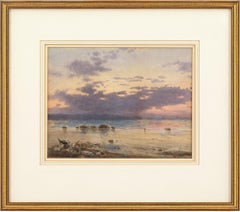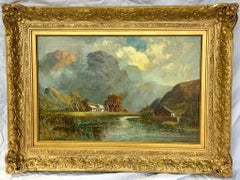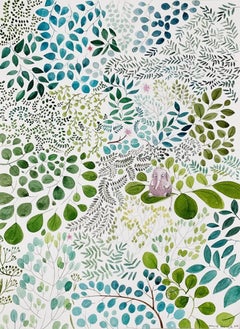William Stephen Coleman Art
to
2
2
2
1
1
Overall Height
to
Overall Width
to
1
1
1
1
1
1
2
3
6,934
3,279
2,514
1,213
2
1
1
1
1
Artist: William Stephen Coleman
19th Century genre oil painting of a woman in a garden with two girls
By William Stephen Coleman
Located in Nr Broadway, Worcestershire
William Stephen Coleman
British, (1829-1904)
By the Fish Pond
Oil on canvas, signed & dated 1898
Image size: 23 inches x 35 inches
Size including frame: 30.25 inches x 42.25 inches
A beautiful painting by William Stephen Coleman of a woman with two girls in a semi classical style by a Mediterranean pond. The woman is depicted resting on a terrace with her young daughter asleep on her lap, whilst another child catches goldfish in a bowl. This tour de force would have most likely been painted by Coleman as an exhibition piece.
William Stephen Coleman was a figurative painter who was born in Horsham in 1829. He was one of 12 children born to a physician named William Thomas Coleman and his wife Henrietta (née Dendy). Three of his siblings Rebecca Coleman (b1837), Helen Cordelia Angell (1847–1884) and George Coleman also became artists, inheriting their artistic talent from their mother’s side of the family. Coleman developed an interest in nature from an early age, producing drawings as a hobby. Despite his ability, he initially followed in his father’s footsteps and trained as a surgeon. However, this proved unsuccessful and by the age of 21 he had turned back to art, later gaining employment with the Dalziel Brothers, a firm of wood engravers who specialised in natural history illustrations.
Sometime during the late 1850’s he moved to London where he married his first wife Henrietta Augusta Boultbee in 1858. Around the same time, he began producing illustrations for books; the first of which was entitled ‘Common Objects of the Country’ and published in 1858. He subsequently published two of his own books ‘Our Woodlands. Heaths, and Hedges’ in 1859 and ‘British Butterflies’ in 1860. After the death of his wife in 1860, his sister Rebecca and brother George went to live with him in Garway Road, Paddington. Rebecca would often assist him with the wood blocks for his illustrations.
As well as working as an engraver, he also began producing classically influenced paintings featuring figures in landscapes. Initially these were executed in watercolours but later extended to oil paintings. He began exhibiting at the Dudley Gallery in 1865 and was one of the original committee members. He continued to exhibit there until 1879 and was a committee member up until 1881.
By 1869, he had also begun to work on pottery decoration and in 1871 was asked by Minton’s to establish an Art Pottery Studio at Kensington Gore. Whilst at Minton’s, he produced figure designs for their ceramic ware. His sister Rebecca also worked at Minton’s and they moved to Belle Vue in Chelsea to be closer to the studio. From 1881, he lived at 3 St John’s Wood Studios, Queens Terrace in Paddington and in 1888 moved to 43 Broadhurst Gardens in Hampstead. In 1893 one of his classically inspired works ‘The Gold Fish Bowl...
Category
19th Century Victorian William Stephen Coleman Art
Materials
Oil, Canvas
William Stephen Coleman, Coastal Landscape With Sunset, Watercolour
By William Stephen Coleman
Located in Cheltenham, GB
This late 19th-century watercolour by British artist William Stephen Coleman (1829-1904) depicts an atmospheric coastal view with sunset.
As the sun slips surreptitiously beyond the...
Category
1890s Aesthetic Movement William Stephen Coleman Art
Materials
Watercolor, Paper
Related Items
Antique Scottish Highland Loch landscape, with sunlit streaming onto the water
By Francis E. Jamieson
Located in Woodbury, CT
Francis Jamieson was a painter in oil and watercolor of highland landscapes and coastal scenes. (The work of this highly prolific artist is curious since the oils and watercolors have two quite distinctive styles and subject matter. The oil paintings are most frequently seen and these are highland landscapes or loch scenes - sometimes they appear to be signed with pseudonyms such as 'W. Richards' and 'Phil Hips' - the location is usually inscribed on the reverse. The watercolors are often coastal scenes with boats and figures on a shore, painted in a more traditional Victorian style, and possibly pre-date the oils. F. E. Jamiesons's beach scenes were published as postcards around 1920 by G. Ajelli & Co. of London on a textured card to give the appearance of oils.
Jamieson is known to have traveled widely in the South of England between the wars selling his work but does not appear to have exhibited.) This quote in parentheses is taken from Jeremy Wood's excellent book 'Hidden Talents - A Dictionary of Neglected Artists Working 1880-1950'.
-
Work by Francis Jamieson can be seen at the usual sites. Please note that on all these sites you will find F. E. Jamieson variously listed as Francis E. Jamieson, F.E.Jamieson, Frank E. Jamieson, Frederick E. Jamieson etc. You may also find some listings under his various pseudonyms of Arnould Pienne, Charles Maurice, Graham Williams...
Category
1910s Victorian William Stephen Coleman Art
Materials
Canvas, Oil
Free Shipping
H 21 in W 29 in
Who needs a mammoth - Book illustration, Polish artist, Watercolor painting
By Joanna Rusinek
Located in Warsaw, PL
Illustration for book by Agnieszka Frączek 'Who needs a mammoth'
JOANNA RUSINEK
Printmaker, illustrator of children's books, author of press ill...
Category
2010s Contemporary William Stephen Coleman Art
Materials
Paper, Watercolor, Pencil
19th century Antique English Victorian Summer Harvest landscape, with figures.
By John Mundell
Located in Woodbury, CT
19th century English Antique Victorian Summertime Harvest landscape, with figures.
John Mundell was a British painter of landscapes as well as river scenes and coastal views. It is suggested that Mundell was a pseudonym of John James Wilson. Mundell’s work was vigorous, bright, and attractive and compares favorably with the work of many of the better artists of his time.
This is a very fine example of the artist's work. It is a rare composition for the artist as he mostly painted marines.
This piece is framed in its original antique gold leaf frame
Category
1870s Victorian William Stephen Coleman Art
Materials
Canvas, Oil
Free Shipping
H 17 in W 25.5 in D 3 in
Antique Breton Fishing Scene French Oil Painting on Canvas Fishermen & Women
Located in Cirencester, Gloucestershire
Breton Fisherfolk on the Shore
French School, early 1900's
signed with initials HB
oil on canvas, unframed
canvas: 15.5 x 20 inches
provenance: private collection, France
condition: ...
Category
Early 20th Century Victorian William Stephen Coleman Art
Materials
Oil, Canvas
19th century English marine Sailing scene of Dutch fishing boats by a harbor
By Henry King Taylor
Located in Woodbury, CT
Henry King Taylor was a marine and coastal scene painter who lived in London. He exhibited at the Royal Academy from 1859 to 1864 with titles includi...
Category
1850s Victorian William Stephen Coleman Art
Materials
Canvas, Oil
Henry King Taylor19th century English marine Sailing scene of Dutch fishing boats by a harbor , 1859
Free Shipping
H 21 in W 33 in
Antique English 19th century View of Venice with St.Marks and the Grand Canal
By Francis Moltino
Located in Woodbury, CT
Francis Moltino (1818–1888) was a 19th-century English landscape painter. Most biographical accounts give his place of birth as Milan, Italy but this is incorrect. Francis Moltino was in fact born Frank George Owen Moulton in Norfolk and no doubt changed his name and reinvented himself in order to sound more exotic. Moltino married Elizabeth Nockold in 1834 and moved to London in the 1840s.
Between 1847 and 1867 he exhibited at the Royal Academy, the British Institution, and the Royal Society of British Artists. Moltino specialized in atmospheric cityscapes of the river Thames and Victorian London, and in particular scenes of Venice in the style of J. M. W. Turner. Moltino died in Wandsworth, South London in April 1888.
This is a bright well-painted example of the artist's work and is framed in its original Antique English frame.
Category
1850s Victorian William Stephen Coleman Art
Materials
Canvas, Oil
Free Shipping
H 21 in W 29 in
Antique Dutch 19th century ships at sea, fishing boats, men rowing.
Located in Woodbury, CT
A very well-painted Dutch 19th century marine scene. The small boat is full of men who are rowing hard to get to the larger vessels, possibly to either take goods on or off the large...
Category
1870s Victorian William Stephen Coleman Art
Materials
Oil, Canvas
Free Shipping
H 16 in W 19.5 in
19th century English village scene with cottages, horses landscape and people
By Georgina Lara
Located in Woodbury, CT
Georgine Lara
English Village landscape
A painting by Georgina Lara depicting a 19th-century English village scene offers a charming and evocative portrayal of a bygone era, captur...
Category
1890s Victorian William Stephen Coleman Art
Materials
Oil, Canvas
Free Shipping
H 17 in W 25 in
Antique oil on canvas, English landscape with River, Church, Cottage at Sunrise
By Daniel Sherrin
Located in Woodbury, CT
Well-painted English late 19th century RIver landscape, with river, Church Cottage at Sunrise
Daniel Sherrin 1868-1940 signed L. Richards This is a framed original oil painting on c...
Category
Early 1900s Victorian William Stephen Coleman Art
Materials
Canvas, Oil
Free Shipping
H 27 in W 37 in
19th century English cottage landscape with mother and child feeding chickens
Located in Woodbury, CT
19th century English/British cottage landscape with mother and child feeding the chickens.
Walter E. Ellis, was born and christened Erasmus Walter Ellis, although he must have preferred Walter to Erasmus, as he signed his paintings Walter E. Ellis, as on this painting, or W. E. Ellis.
Erasmus Walter Ellis was born in Birmingham in 1848, the son of William Ellis...
Category
Late 19th Century Victorian William Stephen Coleman Art
Materials
Oil, Canvas
Free Shipping
H 15 in W 19 in
Wroclaw - Contemporary Watercolor & Ink Landscape Painting, Architecture
By Mariusz Szałajdewicz
Located in Warsaw, PL
Mariusz Szalajdewicz (b. 1974)
Studied at the Faculty of Architecture at Warsaw University of Technology, where he mastered the drawing skill. Architect and urbanist, illustrator.
...
Category
21st Century and Contemporary Realist William Stephen Coleman Art
Materials
Ink, Watercolor, Paper
Antique oil 19th century View of Venice, The Grand Canal Venice
By William Meadows
Located in Woodbury, CT
View of the Grand Canal in Venice by one of England's best-known landscape and Venetian painters.
This example is a very well-painted piece and is a great composition.
It is framed in an English Classic running pattern frame.
Tracing the story of William Meadows, the son of James Meadows, is sometimes a little difficult. In earlier census returns he gave his place of birth as Epping, but in later census returns he said that he was born in Mountnessing in about 1825. Between 1841 and 1901 William is recorded as William James, William George, and in 1881 simply as George, and these apparent changes of name were explained by a chaotic personal life which contrasts with his tranquil paintings of the English countryside and Venice.
An entry in The Fine Arts Journal in 1847, concerning the Theatre Royal, Dumfries, reveals that "The scene-painter is Mr. W.J.Meadows, the son of Mr. Meadows, of the Surrey”. Initially, William had begun his career by following in the family footsteps at one of the theatres where his grandfather had performed. However, his training as a scene painter most probably came closer to home under his father's tuition, possibly at The Lyceum Theatre in London in 1844. (See the previous page on James Meadows for further details).
In 1850, William married Lydia Maria Jarvis (born in Norwich c.1826) at St Pancras Old Church, close to St Pancras Station in London. By the time that the census was taken the following year, William and Lydia were living at 16, High Street in Poole, Dorset. So far it has been not been possible to identify a census entry for 1861 for the couple. However, when William exhibited "A scene in Surrey' at the Royal Hibernian Academy of Arts in Dublin in 1865, he gave his address as 187, Hampstead Road, London, not far from the St Pancras area once again.
The reason for William's obscurity in the 1861 census may lie partially in his financial difficulties, as well as his frequent changes of address. In 1864, The Law Journal's list of impending bankruptcy proceedings included an entry for "Meadows, William George (known as William James Meadows), artist, of Old Kent Road, previously of Beal Road, Old Ford, previously of Wanstead Flats, Wanstead". A family source has revealed that William tried changing career not long afterward, when he became the landlord of The Black Bull Inn in Fyfield in Essex on the 9th November 1866, and that he "gave an opening dinner there" on 29th November 1866. However, if William was trying to achieve financial stability by changing careers, the 1871 census would suggest that it was an unsuccessful interlude.
In 1871 William was recorded under the name of William George but is identifiable as the same person by his age, place of birth, and the personal details of his wife. He no longer gave his profession as an artist, but as an "Eating Housekeeper", back in the East End of London and living at 200, High Street in Shoreditch. Two servants were living with the couple, but more unusually there was also another resident, whose occupation was listed as "bailiff in possession". The presence of a live-in bailiff, therefore, seems to suggest that William's financial difficulties were far from over.
In addition to his financial woes, William’s marriage to Lydia also appears to have been a stormy affair. In 1867 in London she petitioned for a divorce from William, although she must have been initially reconciled to him as the couple was living together (with their bailiff!) in 1871. However in 1874, Lydia once again petitioned for a divorce and this time the separation was definitive, and Lydia moved to a separate address in Holborn where she was living at the time of the 1881 census as a "retired publican". William, meanwhile, married for a second time in Southwark in 1875, under the name of William George Meadows.
His second wife, Helen Grace Higgs, was born in Tipperary in Ireland in about 1841. By the time of the 1881 census, the couple was lodging over a pub at 87, High Holborn in London, where William is recorded simply as "George Meadows, Landscape painter". In the 1891 census, the couple was lodging at The Green Dragon...
Category
1890s Victorian William Stephen Coleman Art
Materials
Canvas, Oil
Free Shipping
H 28 in W 38 in
Previously Available Items
Watering the Flowers, oil on canvas
By William Stephen Coleman
Located in Nr Broadway, Worcestershire
William Stephen Coleman
British, (1829-1904)
Watering the Flowers
Oil on canvas, signed
Image size: 28½ inches x 13½ inches
Size including frame: 36½ inches x 21½ inches
William Coleman was born in Horsham, Surrey in 1829 the son of a physician. He inherited his talent from his mother’s side and his sister Helen Cordelia Coleman (1847-1884) also became an artist. He initially trained as a surgeon before becoming an artist and was a keen naturalist. In 1859 he published and illustrated two books on the subject. He also produced a number of illustrations for other publications including Illustrated News.
He was a follower of the classical movement and specialised in works with figures of maidens in landscapes containing flowers and plants. He was a member of the original committee of the Dudley Gallery, London contributing to the first exhibition in 1865. He continued to exhibit there until 1879, remaining on the committee until 1881. He also exhibited at the Society of British Artists and Arthur Tooth & Sons. In 1869, Coleman experimented in pottery decoration and was asked by Minton to produce figure designs for Minton's ceramic ware. In 1871, under his direction, Minton's Art Pottery Studio in Kensington Gore was established. He died on 22 March 1904 at St John’s Wood.
Examples of his work are held at the Blackpool Museum, Croydon Museum, Glasgow Museum, Victoria Art Gallery, Bath as well as a the V&A. This painting features a similar textile and charger to those in his popular Goldfish painting...
Category
19th Century Victorian William Stephen Coleman Art
Materials
Canvas, Oil
William Stephen Coleman art for sale on 1stDibs.
Find a wide variety of authentic William Stephen Coleman art available for sale on 1stDibs. You can also browse by medium to find art by William Stephen Coleman in paint, canvas, fabric and more. Not every interior allows for large William Stephen Coleman art, so small editions measuring 21 inches across are available. Customers who are interested in this artist might also find the work of William Shayer Senior, David Bates b.1840, and John Horace Hooper. William Stephen Coleman art prices can differ depending upon medium, time period and other attributes. On 1stDibs, the price for these items starts at $767 and tops out at $21,656, while the average work can sell for $11,211.




